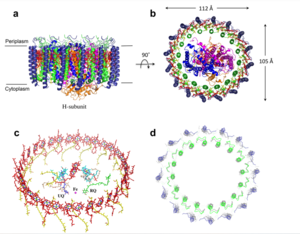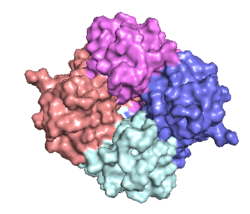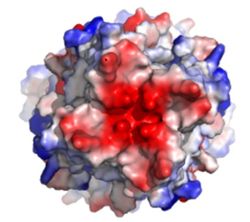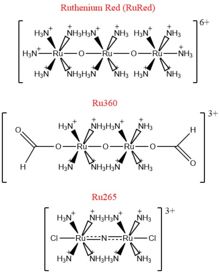User:R. Jeremy Johnson/Mitochondrial Calcium Uniporter
From Proteopedia
(Difference between revisions)
| Line 3: | Line 3: | ||
== Overview == | == Overview == | ||
| - | The mitochondrial calcium uniporter (MCU) complex is the main source of entry for [https://en.wikipedia.org/wiki/Calcium calcium] ions into the [https://en.wikipedia.org/wiki/Mitochondrial_matrix mitochondrial matrix] from the [https://en.wikipedia.org/wiki/Mitochondrion#Intermembrane_space intermembrane space]. MCU channels exist in most [https://en.wikipedia.org/wiki/Eukaryote | + | The mitochondrial calcium uniporter (MCU) complex is the main source of entry for [https://en.wikipedia.org/wiki/Calcium calcium] ions into the [https://en.wikipedia.org/wiki/Mitochondrial_matrix mitochondrial matrix] from the [https://en.wikipedia.org/wiki/Mitochondrion#Intermembrane_space intermembrane space]. MCU channels exist in most [https://en.wikipedia.org/wiki/Eukaryote eukaryotes], but activity is regulated differently in each [https://en.wikipedia.org/wiki/Clade clade].<ref name="Baradaran">PMID:29995857</ref> MCU was definitively assigned in 2011 using a combination of [https://en.wikipedia.org/wiki/Nuclear_magnetic_resonance_spectroscopy NMR spectroscopy], [https://en.wikipedia.org/wiki/Cryogenic_electron_microscopy Cryoelectron microscopy], and [https://en.wikipedia.org/wiki/X-ray_crystallography x-ray crystallography].<ref name="Woods">PMID:31869674</ref> Recent [https://en.wikipedia.org/wiki/Cryogenic_electron_microscopy cryoelectron microscopy] (Cryo-EM) analysis provides a structural framework for understanding the mechanism for calcium selectivity by the MCU.<ref name="Giorgi" /> Like other ion channels, the MCU is highly selective and efficient, allowing calcium ions into the mitochondrial matrix at a rate of 5,000,000 ions per second, even though [https://en.wikipedia.org/wiki/Potassium potassium] ions are over 100,000 times more abundant in the intermembrane space.<ref name="Baradaran"/> |
| - | Under resting conditions, the calcium concentration in the mitochondria is about the same as in the [https://en.wikipedia.org/wiki/Cytoplasm cytoplasm], but when stimulated, | + | Under resting conditions, the calcium concentration in the mitochondria is about the same as in the [https://en.wikipedia.org/wiki/Cytoplasm cytoplasm], but when stimulated, mitochondrial calcium concentration increases 10 to 20-fold.<ref name="Giorgi">PMID:30143745</ref> ([https://en.wikipedia.org/wiki/Mitochondria_associated_membranes Mitochondria-associated ER membranes]) exist between the mitochondria and the [https://en.wikipedia.org/wiki/Endoplasmic_reticulum endoplasmic reticulum] facilitate efficient transport of calcium ions.<ref name="Wang">PMID:28882140</ref> The transfer of electrons through [https://en.wikipedia.org/wiki/Electron_transport_chain#Mitochondrial_redox_carriers respiratory complexes I-IV] produces the energy to pump [https://en.wikipedia.org/wiki/Hydrogen_ion hydrogen ions] into the intermembrane space and establish the proton [https://en.wikipedia.org/wiki/Electrochemical_gradient electrochemical gradient] potential.<ref name="Giorgi"/> This negative electrochemical potential is the driving force that moves positively charged calcium ions into the mitochondrial matrix.<ref name="Giorgi"/> Calcium uptake and efflux must be tightly regulated to controll essential [https://en.wikipedia.org/wiki/Citric_acid_cycle Krebs cycle] enzyme activity, including [http://proteopedia.org/wiki/index.php/Pyruvate_dehydrogenase pyruvate dehydrogenase], [https://en.wikipedia.org/wiki/Oxoglutarate_dehydrogenase_complex α-ketoglutarate dehydrogenase], and [http://proteopedia.org/wiki/index.php/Isocitrate_dehydrogenase isocitrate dehydrogenase], while avoiding calcium overload and [https://en.wikipedia.org/wiki/Apoptosis apoptosis].<ref name="Wang"/> |
| - | + | ||
| - | + | ||
==Mitochondrial Calcium Uniporter Complex== | ==Mitochondrial Calcium Uniporter Complex== | ||
| - | The | + | The MCU complex exists as a large complex (around 480 kDa in humans) made up of both pore-forming and regulatory subunits.<ref name="Wang"/> The MCU complex is composed of the MCU as well as regulatory subunits including the mitochondrial calcium uptake proteins MICU1 and MICU2, essential MICU regulator (EMRE), MCU regulatory subunit b (MCUb), and MCU regulator 1 (MCUR1). <ref name="Fan" /> The mitochondrial uptake proteins (MICU1 and MICU2) are intermembrane regulatory proteins that use their [https://en.wikipedia.org/wiki/EF_hand EF hand domains] to grab intermembrane calcium and to control transport through the channel of the MCU.<ref name="Wang"/> When calcium ion concentration in the intermembrane space is low, MICU1 and 2 block the MCU to prevent uptake of calcium.<ref name="Wang"/> In high calcium concentrations, calcium binds to these regulatory proteins and they undergo a conformational change to allow calcium ions through the MCU and into the matrix.<ref name="Wang"/> When calcium levels are below 500 nM, MICU1 can block movement of calcium by itself, calcium levels between 500 nM and 1,500 nM require both MICU1 and MICU2 to block ion entry, and any concentration over 1,500 nM is sufficient for calcium entry.<ref name="Giorgi"/> Another regulatory protein, MCUR1 is a cofactor in the assembly of the [https://en.wikipedia.org/wiki/Electron_transport_chain respiratory chain] rather than an essential part of the uniporter.<ref name="Giorgi"/> Though the MCU is able to take up calcium independently, two other membrane spanning subunits, the MCUb and the essential MCU regulator (EMRE), connect to the MCI and add further regulatory mechanisms.<ref name="Wang"/> MCUb is similar to MCU, but through key amino acid substitutions serves an inhibitory role.<ref name="Wang"/> The EMRE contributes to regulation of calcium intake in the by connecting MICU1 and MICU2 to the MCU.<ref name="Giorgi"/><ref name="Wang"/> |
| - | [[Image:structure.png|300 px|right|thumb|Figure 1: Structure of mitochondrial calcium uniporter colored by functional domain. The transmembrane domain is highlighted in salmon, the | + | [[Image:structure.png|300 px|right|thumb|Figure 1: Structure of mitochondrial calcium uniporter colored by functional domain. The transmembrane domain is highlighted in salmon, the linker domain spanning the mitochondrial matrix in light cyan, coiled-coil domain in dark violet, and the N-terminal domain in slate blue. [https://en.wikipedia.org/wiki/Protein_Data_Bank PDB] [https://www.rcsb.org/structure/6DT0 6DT0]]] |
==MCU Structure== | ==MCU Structure== | ||
| - | The <scene name='83/832952/Starting_scene/5'> | + | The <scene name='83/832952/Starting_scene/5'>MCU</scene> is the ion channel component of the MCU complex (Figure 1). An NMR structure of an inactive MCU from ''C. elegans'' showed a pentameric arrangement, but the recent crystal and cryo-EM structures of multiple MCUs reaffirmed that active eukaryotic MCU exists as four monomers, identical in sequence, arranged and packed together such that they structurally form a <scene name='83/832952/Dimer_of_dimers/5'>dimer of dimers</scene> in a tetrameric truncated pyramid (Figure 2).<ref name="Woods">PMID:31869674</ref> The MCU protein is composed of a <scene name='83/837230/Transmembrane_domain/3'>transmembrane domain</scene>, a <scene name='83/837230/Coiled_coil/3'>coiled coil domain</scene>, and a <scene name='83/837230/Nterm/2'>N-Terminal Domain</scene> (NTD) (Figure 1).<ref name="Woods"/> The hydrophobic <scene name='83/837230/Transmembrane_domain/3'>transmembrane domain</scene> is located in the ([https://en.wikipedia.org/wiki/Inner_mitochondrial_membrane inner mitochondrial membrane]) while the hydrophilic coiled-coil domain and NTD are positioned in the mitochondrial matrix.<ref name="Baradaran"/> |
| - | [[Image:Nterm.png|250 px|right|thumb|Figure 2: Symmetry and organization of | + | [[Image:Nterm.png|250 px|right|thumb|Figure 2: Symmetry and organization of MCU dimer of dimers viewed from the inner mitochondrial membrane [https://en.wikipedia.org/wiki/Protein_Data_Bank PDB] [https://www.rcsb.org/structure/6DT0 6DT0]]] |
===Transmembrane Domain=== | ===Transmembrane Domain=== | ||
| - | The <scene name='83/837230/Transmembrane_domain/3'>transmembrane domain</scene> is | + | The <scene name='83/837230/Transmembrane_domain/3'>transmembrane domain</scene> is inserted into the inner mitochondrial membrane and opens to the inner membrane space (Figure 1). The <scene name='83/837230/Transmembrane_domain/3'>transmembrane domain</scene> consists of eight separate helices (TM1 and TM2 from each subunit) with <scene name='83/832952/Starting_scene/5'>four-fold</scene> symmetry that are connected by hydrophobic amino acids in the intermembrane space (Figure 2).<ref name="Baradaran"/> The small <scene name='83/832952/Selectivity_filter/3'>selectivity filter</scene> pore, highly specific for calcium binding is located in the interior of the bundle of four packed <scene name='83/832952/Tm2/2'>TM2</scene> helices while the four helices of <scene name='83/837230/Transmembrane_1/2'>TM1</scene> surround this TM2 bundle. <scene name='83/837230/Transmembrane_1/2'>TM1</scene> packs tightly against <scene name='83/832952/Tm2/2'>TM2</scene> from the neighboring subunit which conveys a sense of domain-swapping.<ref name="Fan">PMID:29995856</ref> |
===Coiled-coil Domain=== | ===Coiled-coil Domain=== | ||
| - | + | The N-terminal domains of the <scene name='83/832952/Tm1/2'>TM1</scene> helices extend into the matrix and form coiled-coils with a C-terminal helix.<ref name="Baradaran"/> These "legs" are separated from each other which allows enough space for calcium ions to diffuse out into the matrix.<ref name="Baradaran"/> The <scene name='83/837230/Coiled_coil/3'>coiled coil</scene> domain is the first subsection of the soluble domain, which resides in the inner mitochondrial membrane. The coiled coil functions as the joints of the uniporter, providing flexibility to promote transport of Ca<sup>2+</sup>ions down their concentration gradient.<ref name="Fan" /> When Ca<sup>2+</sup> ions binds to the selectivity pore, the coiled-coil swings approximately 8° around its end near the <scene name='83/837230/Nterm/2'>NTD</scene>. This movement propagates to the top of the transmembrane domain, where the pore is located about 85 Å away. The coiled coil's flexibility can be attributed to the disordered packing between subunits. Subunits A and C adopt different conformations than the B and D subunits, although they superimpose closely.<ref name="Fan" /> The coiled-coil domain is also required for proper assembly of the MCU and is [https://en.wikipedia.org/wiki/Post-translational_modification post-translationally modified].<ref name="Fan"/> | |
===N-terminal Domain=== | ===N-terminal Domain=== | ||
| - | + | Each leg of the coiled-coil domain extends into the <scene name='83/832952/New_ones/4'>NTD</scene>.<ref name="Baradaran"/> The soluble domain, including the linker, coiled-coil, and NTD, is wider than the transmembrane domain (Figure 1), allowing calcium ions passed through the selectivity filter to rehydrate, increasing the conductivity of ions through the uniporter into the mitochondrial matrix.<ref name="Fan" /> While the MCU can intake calcium without the NTD, the NTD serves regulatory functions, including bending <scene name='83/837230/Transmembrane_domain/3'>transmembrane helices</scene> to constrict the pore.<ref name="Baradaran"/><ref name="Fan"/> Reorganization in the NTD due to shifts in the <scene name='83/837230/Coiled_coil/3'>coiled coil</scene> domain alters membrane packing, facilitating a rotamer switch between a pair of tyrosine residues controlling calcium flow through the pore. | |
===Selectivity Filter=== | ===Selectivity Filter=== | ||
| - | [[Image:Electronegativity_MCU_4.jpg|250 px|right|thumb|Figure 3: | + | [[Image:Electronegativity_MCU_4.jpg|250 px|right|thumb|Figure 3: Electrostatic potential of MCU viewed from the intermembrane space. The high concentration of negatively charged residues (red), surrounding the selectivity filter, attracts the positively charged calcium ions [https://en.wikipedia.org/wiki/Protein_Data_Bank PDB] [https://www.rcsb.org/structure/6DT0 6DT0]]] |
| - | The <scene name='83/832952/Selectivity_filter/3'>selectivity filter</scene> of the MCU is composed | + | The <scene name='83/832952/Selectivity_filter/3'>selectivity filter</scene> of the MCU is composed of multiple layers of acidic amino acids near the narrow mouth of the channel and is responsible for the high affinity and selectivity of the MCU for calcium ([https://en.wikipedia.org/wiki/Dissociation_constant dissociation constant] of less than 2nM) (Figure 3).<ref name="Baradaran"/> Negatively charged aspartates <scene name='83/832952/New_ones/2'>(Asp333)</scene> at the mouth of the MCU congregate positively charged <scene name='83/832952/Calcium/4'>calcium ions</scene> at the entrance of the channel.<ref name="Baradaran"/> A highly conserved <scene name='83/832952/Dxxe_motif/7'>WDXXEP</scene> [https://en.wikipedia.org/wiki/Sequence_motif motif] in the TM2 helices form the selectivity pore which selects for calcium transport over other similar ions.<ref name="Baradaran"/> |
The <scene name='83/832952/Dxxe_motif/7'>WDXXEP</scene> motif consists of <scene name='83/832952/Tryptophan/2'>Trp224</scene> at the N-terminal end, <scene name='83/832952/Selectivity_filter_asp/2'>Asp225</scene>, <scene name='83/832952/Selectivity_filter_glu/3'>Glu228</scene>, and <scene name='83/832952/New_ones/5'>Pro229</scene>.<ref name="Baradaran"/> The negatively charged side chains of Asp225 and <scene name='83/832933/Glu_358/4'>Glu228</scene> point towards the pore.<ref name="Baradaran"/> The <scene name='83/832933/Diameter/2'>diameter</scene> of the carboxyl ring is about 4Å, allowing only a dehydrated Ca<sup>2+</sup> ion to bind. The combination of these radii and high negative charge (Figure 3) account for the selectivity of the MCU. For example, potassium has an [https://en.wikipedia.org/wiki/Ionic_radius ionic radius] of 1.38Å which is much larger than the 1.00Å ionic radius of calcium and potassium cannot fit into the negatively charged ring formed by <scene name='83/832952/Selectivity_filter_glu/3'>Glu228</scene>.<ref name="Baradaran"/> Additionally, even though sodium ions have a similar ionic radius, the +2 charge on calcium is better matched to coordination with the glutamate residues.<ref name="Baradaran"/> | The <scene name='83/832952/Dxxe_motif/7'>WDXXEP</scene> motif consists of <scene name='83/832952/Tryptophan/2'>Trp224</scene> at the N-terminal end, <scene name='83/832952/Selectivity_filter_asp/2'>Asp225</scene>, <scene name='83/832952/Selectivity_filter_glu/3'>Glu228</scene>, and <scene name='83/832952/New_ones/5'>Pro229</scene>.<ref name="Baradaran"/> The negatively charged side chains of Asp225 and <scene name='83/832933/Glu_358/4'>Glu228</scene> point towards the pore.<ref name="Baradaran"/> The <scene name='83/832933/Diameter/2'>diameter</scene> of the carboxyl ring is about 4Å, allowing only a dehydrated Ca<sup>2+</sup> ion to bind. The combination of these radii and high negative charge (Figure 3) account for the selectivity of the MCU. For example, potassium has an [https://en.wikipedia.org/wiki/Ionic_radius ionic radius] of 1.38Å which is much larger than the 1.00Å ionic radius of calcium and potassium cannot fit into the negatively charged ring formed by <scene name='83/832952/Selectivity_filter_glu/3'>Glu228</scene>.<ref name="Baradaran"/> Additionally, even though sodium ions have a similar ionic radius, the +2 charge on calcium is better matched to coordination with the glutamate residues.<ref name="Baradaran"/> | ||
Revision as of 16:38, 2 December 2020
Mitochondrial Calcium Uniporter
| |||||||||||
References
- ↑ 1.00 1.01 1.02 1.03 1.04 1.05 1.06 1.07 1.08 1.09 1.10 1.11 1.12 1.13 1.14 1.15 1.16 1.17 1.18 1.19 1.20 1.21 1.22 1.23 1.24 Baradaran R, Wang C, Siliciano AF, Long SB. Cryo-EM structures of fungal and metazoan mitochondrial calcium uniporters. Nature. 2018 Jul 11. pii: 10.1038/s41586-018-0331-8. doi:, 10.1038/s41586-018-0331-8. PMID:29995857 doi:http://dx.doi.org/10.1038/s41586-018-0331-8
- ↑ 2.0 2.1 2.2 2.3 2.4 2.5 2.6 2.7 2.8 2.9 Woods JJ, Wilson JJ. Inhibitors of the mitochondrial calcium uniporter for the treatment of disease. Curr Opin Chem Biol. 2019 Dec 20;55:9-18. doi: 10.1016/j.cbpa.2019.11.006. PMID:31869674 doi:http://dx.doi.org/10.1016/j.cbpa.2019.11.006
- ↑ 3.0 3.1 3.2 3.3 3.4 3.5 3.6 3.7 3.8 Giorgi C, Marchi S, Pinton P. The machineries, regulation and cellular functions of mitochondrial calcium. Nat Rev Mol Cell Biol. 2018 Nov;19(11):713-730. doi: 10.1038/s41580-018-0052-8. PMID:30143745 doi:http://dx.doi.org/10.1038/s41580-018-0052-8
- ↑ 4.00 4.01 4.02 4.03 4.04 4.05 4.06 4.07 4.08 4.09 4.10 4.11 Wang CH, Wei YH. Role of mitochondrial dysfunction and dysregulation of Ca(2+) homeostasis in the pathophysiology of insulin resistance and type 2 diabetes. J Biomed Sci. 2017 Sep 7;24(1):70. doi: 10.1186/s12929-017-0375-3. PMID:28882140 doi:http://dx.doi.org/10.1186/s12929-017-0375-3
- ↑ 5.00 5.01 5.02 5.03 5.04 5.05 5.06 5.07 5.08 5.09 5.10 5.11 5.12 Fan C, Fan M, Orlando BJ, Fastman NM, Zhang J, Xu Y, Chambers MG, Xu X, Perry K, Liao M, Feng L. X-ray and cryo-EM structures of the mitochondrial calcium uniporter. Nature. 2018 Jul 11. pii: 10.1038/s41586-018-0330-9. doi:, 10.1038/s41586-018-0330-9. PMID:29995856 doi:http://dx.doi.org/10.1038/s41586-018-0330-9
- ↑ Yoo J, Wu M, Yin Y, Herzik MA Jr, Lander GC, Lee SY. Cryo-EM structure of a mitochondrial calcium uniporter. Science. 2018 Jun 28. pii: science.aar4056. doi: 10.1126/science.aar4056. PMID:29954988 doi:http://dx.doi.org/10.1126/science.aar4056
Student Contributors
Ryan Heumann
Lizzy Ratz
Holly Rowe
Madi Summers
Rieser Wells




